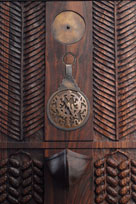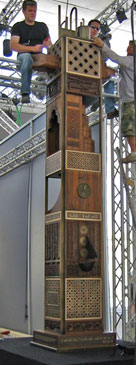| When officials at Texas A&M University wanted to commission a sculpture for the institution’s Qatar campus, their search for an artist went no further than their own backyard.
Mark Weichold, newly appointed dean and chief executive officer of Texas A&M University at Qatar, and Charles Bowman, the outgoing dean, tapped architecture professor and renowned artist Rodney Hill for the job.
“Mark and Chuck were looking for a sculpture to present as a gift to the Qatar campus’s major benefactors, His Highness Sheikh Hamad Khalifa Al-Thani and Her Highness Sheikha Mozah Bint Nasser Al-Missned,” Hill says, “and they came to me with an idea — they wanted a sculpture that highlighted the Arab world’s contributions to culture, engineering and science.”
Hill received no other instructions when he was given the commission at the beginning of October 2006, but he was given a deadline — mid-March 2007.
“It was a big job, a bit overwhelming,” he notes. “The first thing I did was go to Evans Library, where I received fantastic support from the staff, especially from Sandy Tucker, one of the research librarians. She helped locate dozens of books on Arab culture and science, even getting me, in record time, a just-released book I had spotted on the Internet.
“Never having researched the topic before, I was just amazed at all the things we owe to the Arab countries — among other contributions, Arab scientists and engineers gave us the foundations of chemistry, the first hospital and the first libraries. The Arab world was the center of knowledge for a long period of time.”
Hill notes that he found a 9th century medical textbook featuring surgical instruments. “Over one-half of the instruments depicted have the same design as their modern counterparts,” he says. “The only difference is that the modern surgical instruments are made of stainless steel, which of course was unknown 1,000 years ago.”
Based on his research, Hill drew up a rough sketch outlining his artistic vision. “I decided to craft an ‘obelisk of knowledge’ inspired by an ancient Arab concept,” he says, “that intertwines some history with scientific contributions.”
The foundation upon which the obelisk rests houses four bronze panels with the following quotation inscribed in Arabic: “We did indeed offer the Trust to the Heavens and the Earth and the Mountains; they refused to undertake it, being afraid thereof: but man undertook it; He was indeed unjust and foolish,” Qur’anic verse 72, Surat Al-Ahzab.
“I found that Qatar’s ancient civilization was based on pearl mining, so the foundation of the obelisk became a layer of carved oysters and pearls. “Moving up the obelisk, the next level includes bronze screens patterned from Arab designs, and the dedication panels inscribed in both English and Arabic to HH Sheikha Mozah and Education City.”
On panels adjacent to the hand carved stylized dates and date palm tree leaves, is a carved model of an ancient oyster boat protruding from opposite sides of the obelisk. Above the hull of the fishing boat is a bronze replica of the antique Arabic Astrolabe that was the foundation for navigational devices.
Four bronze plaques in Arabic are representations of mathematical developments such as trigonometry, algebra, algorithm, decimal fractions, chemistry, pharmacy and optics as well as reference to the “House of Wisdom” that was a modern day clearing house of literary translations of the known world at that time are seen under the stylized observatory which represents Arabic contributions to early astronomy.
From his reading, Hill determined that ancient Arabs found caves from which to observe the stars. “The mouths of such caves framed particular constellations. Stairs were cut into the walls of the caves,” he explains. “As one ascended the stairs, more and more of the constellation became visible for better viewing and study.” This concept is represented by the elegant carved wooden steps leading into the interior of the obelisk. Embedded in the side behind the stairs is an authentic 19th century Persian sundial and compass.
Looking above the stairs and through an ancient, geometric Arabic star pattern screen cast in bronze, is a carved walnut dome representing the sky. From its center hangs a bronze replica of a celestial armillary globe — a tool for observing the stars.
Above the sky dome is an abstract symbol of Arabic architecture housing a computerized reproduction of a petroleum tri-bit representing a current tool of the oil industry. Framing the opening of the architectural dome are symbols (zeros and ones) showing how the binary code and computer programming now controls the oil industry. On two sides of the dome are laser cut classical intricate, wooden geometric Arabic patterns and mathematical formulas that represent Electrical, Petroleum, Chemical and Civil Engineering.
The next layer of carved objects includes chemical and pharmacy symbols, with a human eye looking down on them, to represent the Arab world’s contributions to optometry, among the first. The adjacent panel depicts ancient medical tools. Near the top of the obelisk are carved the Qatar flag and the tree symbol of the Qatar Foundation for Education, Science and Community Development, which has fully funded Education City in Doha, where the Texas A&M engineering campus is located. The Qatar Foundation represents the ancient House of Wisdom, which translated books from all over the world and helped place the Arab world, which had the first universities, at the center of education and libraries. “Read” is also incorporated in the panel above ancient bamboo calligraphy pens.
The final bronze screens are composed of printed circuits to imitate an Arabic geometric screen with a LNG tanker breaking through the screens to illustrate the educational thrust that is propelling Qatar to excellence and the interconnectiveness of present and future technologies and Qatar’s natural resources. The crown of the obelisk is an abstract representation of oil and gas pipelines and holding tanks representing Qatar’s world position in the energy field.
Hill says Weichold and Bowman approved the design by the first of November, after seeing just his rough sketch. “They trusted me to finish the job and allowed me to do so with artistic license,” he says.
Hill, with the help of his wife Susan, carved the wooden part of the sculpture from walnut. A local woodworker, Eric Wendt, a 1993 Texas A&M graduate, mocked up the wood blanks of the obelisk according to Hill’s drawings. For the bronze plaques, screens and the brass frame for the entire obelisk, Hill sought the casting expertise of local metalworker Steve Baker of Timeworks and the welding expertise of Kenneth Kleckley, also an Aggie graduate, of Brazos Industries.
“The final production of the obelisk was a real fast track group effort,” Hill says.
Hill and his subcontractors assembled the whole thing together at Timeworks in late February, and the sculpture was packed in bubble wrap, crated and shipped by air to the Doha campus. Hill arrived in Doha with some fragile pieces of the sculpture in his carry-on just two days before the ceremonies marking the formal investiture of Weichold and the dedication of Texas A&M’s new engineering building there.
He supervised the unpacking, assembly and erection of the 900 pound, 13-foot tall obelisk, which was placed on a platform, to be wheeled onto the stage and presented to HH Sheikha Mozah Bint Nasser Al-Missned during the dedication. The sculpture will be installed in its permanent place, in front of the Texas A&M facilities on the Education City campus, at the end of May.
“I believe that Her Highness was thrilled with the gift,” Hill said. “Immediately after it was given to her, she granted me an audience to thank me in person.”
Hill also was invited to a dinner at the palace of His and Her Highness, along with Texas Governor Rick Perry, Texas A&M interim president Eddie J. Davis, Provost David Prior, The Texas A&M System Board of Regents and their wives, Mrs. Becky Gates, and many other dignitaries including ambassadors and ministers of Qatar’s oil ministry.
Some of Hill’s other sculptures depict various aspects of the Aggie experience, including the ceremonial mace carried at solemn university events such as commencement, the ceremonial key featured at the 1997 dedication of the George Bush Library and Museum, a walnut scroll for the Sanders Corps Center, a bronze Muster sculpture in the Academic Plaza and an 8-foot-tall wood and bronze obelisk in the Sterling C. Evans Library.
But perhaps his most famous work – or the one seen by more Aggies, future Aggies and Aggieland visitors – is a mural depicting the history of Texas A&M, carved by Hill and his wife, Susan. The six 8-by-3 foot walnut panels were unveiled in 1976 and today may be seen in the Memorial Student Center, in the first floor hallway adjoining the Flag Room.
Hill’s work is also featured not only around the Brazos Valley, where he has created sculptures, doors and furniture for private residences, businesses, schools and churches, but also throughout the country and the world. One of his sculptures is featured in the Texas Room of the American Revolution Museum in Washington D.C.
Hill earned a bachelor’s degree in architecture from Texas Tech University and masters from the University of California-Berkeley. A member of the College of Architecture faculty since 1969, he has been recognized for his creativity with the title of “Champion of Creativity Award,” bestowed on him by the American Creativity Association.
He is a self-taught wood carver, but he credits the development of his artistic abilities to his parents – his father was a commercial artist and his mother, a painter.
“The way I grew up, art was natural,” he says. “Art was just something you did, like breathing.”
| 



